Collection of materials relating to neuro-ophthalmology as part of the Neuro-Ophthalmology Virtual Education Library.
NOVEL: https://novel.utah.edu/
TO
- NOVEL822
| Title | Creator | Description | Subject | ||
|---|---|---|---|---|---|
| 1 |
 |
Introduction to the Neurological Examination in NANOS NOTE | Padmaja Sudhakar, MD | An introduction to the neurological examination. | Neurology; Neurological Examination |
| 2 |
 |
Introduction to Examination of Eye Movements and Alignment in NANOS NOTE | Jason H. Peragallo, MD | Introduction to Examination of Eye Movements and Alignment | Eye Movement; Alignment; Examination |
| 3 |
 |
Introduction to Diagnostic Tests in NANOS NOTE | Amanda D. Henderson, MD | An introduction to Diagnostic Tests | Diagnostic Testing |
| 4 |
 |
Introduction to Examination of the Pupil in NANOS NOTE | Clare Fraser, MBBS, MMed | Introduction to Examination of the Pupil | Pupil; Examination |
| 5 |
 |
Introduction to Funduscopic Examination in NANOS NOTE | Rahul Sharma, MD, MPH | An introduction to Funduscopic Examination | Funduscopy; Examination |
| 6 |
 |
Introduction to Examination of the Orbit and the Extraocular Structures in NANOS NOTE | Julie Falardeau, MD | Introduction to Examination of the Orbit and the Extraocular Structures | Orbit; Anatomy |
| 7 |
 |
Introduction to the NANOS Neuro-Ophthalmology Techniques of Examination (NOTE) | Karl C. Golnik, MD | An introduction to the NANOS Neuro-Ophthalmology Techniques of Examination (NOTE) | Examination; Eye Exam |
| 8 |
 |
Introduction to Evaluation in Special Situations in NANOS NOTE | John Pula, MD | An introduction to NOTE sections on Examination of the Comatose Patient and Examination of the Pediatric Patient. | Patient Examination; Pediatric Patient; Examination |
| 9 |
 |
Botulinum Toxin and Migraine | Benjamin Frishberg, MD, FAAN, FNANOS | A video describing the use of botulinum toxin (Botox) for the treatment of migraine. | Botox; Botulinum Toxin; Migraine |
| 10 |
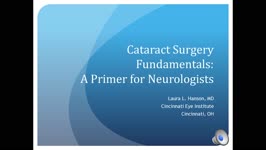 |
Cataract Surgery | Laura L. Hanson, MD | A narrated slide presentation on the basics of cataract surgery. | Cataracts; Surgical Procedures |
| 11 |
 |
Optic Chiasm | Yesha Shah, BSA, BBA; Amanda Henderson, MD | Overview of the anatomy of the optic chiasm. | Optic Chiasm; Anatomy |
| 12 |
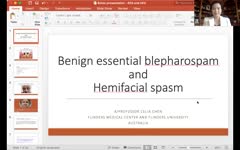 |
Benign Essential Blepharospasm and Hemifacial Spasm | Celia Chen, MBBS, PhD, FRANZCO | Narrated lecture on treatment of benign essential blepharospasm and hemifacial spasm. | Benign Essential Blepharospasm; Hemifacial Spasm |
| 13 |
 |
Complications of Strabismus Surgery and Botox | W. Walker Motley, MD | A narrated video slideshow outlining complications associated with strabismus surgery. | Strabismus; Surgery; Surgical Complications; Botox |
| 14 |
 |
Inferior Orbital Fissure | Yesha Shah, BSA, BBA; Amanda Henderson, MD | Narrated lecture describing the inferior orbital fissure. | Inferior Orbital Fissure |
| 15 |
 |
Practice Based Learning and Improvement (PBLI) | Karl C. Golnik, MD, MEd | Video describing methods and best practices of Practice Based Learning and Improvement (PBLI). | Practice Based Learning and Improvement (PBLI) |
| 16 |
 |
Professionalism and Communication Skills | Karl C. Golnik, MD, MEd | Lecture covering professionalism and communication skills. | Professionalism; Communication Skills |
| 17 |
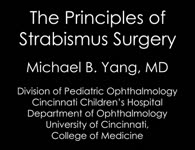 |
Principles of Strabismus Surgery | Michael B. Yang, MD | A video demonstrating a medial rectus recession. | Strabismus; Surgery; Surgery Demonstrations |
| 18 |
 |
Visual Maturation | Yesha Shah, BSA, BBA; Amanda Henderson, MD | Video lecture covering visual maturation. | Visual Maturation; Foveal Development; Vision in Infants |
| 19 |
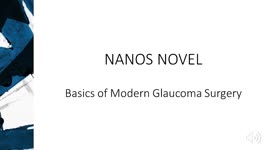 |
Principles of Glaucoma Surgery | Aubrey Tirpack, MD | A video outlining the principles of glaucoma surgery for neuro-ophthalmologists. | Glaucoma; Glaucoma Surgery; Principles of Surgery |
| 20 |
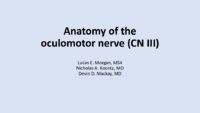 |
Anatomy of the Oculomotor Nerve (CN III) | Lucas E. Morgan, MS4; Nicholas A. Koontz, MD; Devin D. Mackay, MD | A detailed overview of the anatomic course of CN III, including a detailed pathway description and labeled MRI images, gross anatomy pictures, and structural models. | CN III; Third Cranial Nerve; Oculomotor Nerve; Anatomy; MRI |
| 21 |
 |
Common Patterns of Visual Field Defects | Sean Gratton, MD; Sarah Lam, 6th year BA/MD | Lecture covering common visual field defects, including those of the retina, optic nerve, chiasm, and retrochiasmal. | Visual Field Defects |
| 22 |
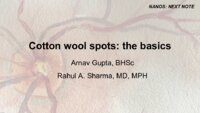 |
Cotton Wool Spots: The Basics | Arnav Gupta, BHSc; Rahul Sharma, MD, MPH | A presentation describing cotton wool spots, an abnormal finding on funduscopic exam of the retina of the eye. | Cotton Wool Spots; Retina |
| 23 |
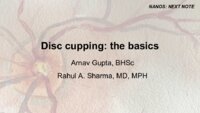 |
Disc Cupping: The Basics | Arnav Gupta, BHSc; Rahul Sharma, MD, MPH | A presentation describing optic disc cupping, due to damage of optic nerve fibres. | Disc Cupping; Optic Disc |
| 24 |
 |
Progressive Supranuclear Palsy (PSP) | Molly Cincotta, MD; Ali G. Hamedani, MD, MHS | Objectives:; To provide an overview of PSP and its pathophysiology;; To present typical clinical features of the disease with a focus on ocular findings;; To provide a template for work up, diagnosis and treatment; ; To demonstrate typical eye movement abnormalities seen in PSP | Progressive Supranuclear Palsy (PSP) |
| 25 |
 |
Computed Tomography (CT): Principles, Technique, and Neuro-ophthalmic Applications | Alex Fraser, MD | Presentation covering Computed Tomography principles, adverse effects, comparison vs. MRI, and assorted examples of neuro-ophthalmic interest. | Computed Tomography (CT) |
| 26 |
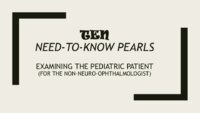 |
Examining the Pediatric Patient for Non-Neuro-ophthalmologists | John Pula, MD | Ten need-to-know pearls for examining the pediatric patient, for non-neuro-ophthalmologists. | Pediatric Patient Exam |
| 27 |
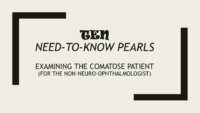 |
Examining the Comatose Patient for Non-Neuro-ophthalmologists | John Pula, MD | Seven need-to-know pearls for examining the pediatric patient, for non-neuro-ophthalmologists. | Comatose Patient Exam |
| 28 |
 |
Visual Fields Part 2: Interpreting The Test Results | Jonathan Trobe, MD | Discussion of interpreting the results of visual field testing. | Visual Fields |
| 29 |
 |
Visual Fields Part 1: Performing The Tests | Jonathan Trobe, MD | Discussion and demonstration of visual field testing. | Visual Fields |
| 30 |
 |
Coordination Exam: Abnormal Examples: Heel-to-shin (x2) (includes Spanish audio & captions) | Paul D. Larsen, MD | The patient with ataxia of the lower extremity will have difficulty placing the heel on the knee with a side-to-side irregular over- and undershooting as the heel is advanced down the shin. Dysmetria on heel-to-shin can be seen in midline ataxia syndromes as well as cerebellar hemisphere disease so ... | Coordination Examination; Heel-shin Test |
| 31 |
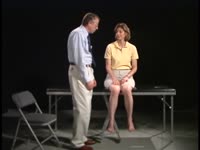 |
Coordination Exam: Normal Exam: Finger-to-nose (includes Spanish audio & captions) | Paul D. Larsen, MD | The patient moves her pointer finger from her nose to the examiner's finger as the examiner moves his finger to new positions and tests accuracy at the furthest outreach of the arm. NeuroLogic Exam has been supported by a grant from the Slice of Life Development Fund at the University of Utah, the D... | Coordination Examination; Finger-to-nose Test |
| 32 |
 |
Coordination Exam: Abnormal Examples: Finger-to-nose (x2) (includes Spanish audio & captions) | Paul D. Larsen, MD | The patient places her heel on the opposite knee then runs the heel down the shin to the ankle and back to the knee in a smooth coordinated fashion. NeuroLogic Exam has been supported by a grant from the Slice of Life Development Fund at the University of Utah, the Department of Pediatrics and the O... | Coordination Examination; Finger-to-nose Test |
| 33 |
 |
Coordination Exam: Normal Exam: Heel-to-shin (includes Spanish audio & captions) | Paul D. Larsen, MD | The patient places her heel on the opposite knee then runs the heel down the shin to the ankle and back to the knee in a smooth coordinated fashion. NeuroLogic Exam has been supported by a grant from the Slice of Life Development Fund at the University of Utah, the Department of Pediatrics and the O... | Coordination Examination; Heel-shin Test |
| 34 |
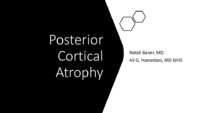 |
Posterior Cortical Atrophy | Natali V. Baner, MD; Ali G. Hamedani, MD, MHS | PowerPoint providing an overview of the definition, clinical presentation and treatment of posterior cortical atrophy | Posterior Cortical Atrophy |
| 35 |
 |
Dementia: Overview and Classification | Molly Cincotta, MD; Whitley Aamodt, MD; Ali G. Hamedani, MD, MHS | PowerPoint providing a broad overview of dementia, including definition, clinical findings, work up, diagnosis, classification, and management. | Dementia |
| 36 |
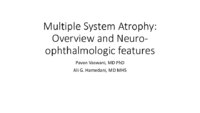 |
Multiple System Atrophy: Overview and Neuro-ophthalmologic Features | Pavan Vaswani, MD, PhD, Movement Disorders Fellow; Ali G. Hamedani, MD, MHS | Objectives: Know the key pathologic features of Multiple System Atrophy; Recognize the clinical presentation, including neuro-ophthalmologic features; Understand the symptomatic therapies and prognosis | Multiple System Atrophy |
| 37 |
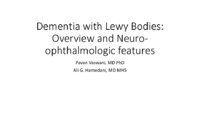 |
Dementia with Lewy Bodies: Overview and Neuro-ophthalmologic features | Pavan Vaswani, MD, PhD; Ali G. Hamedani, MD, MHS | Objectives: Recognize the difference between Dementia with Lewy Bodies and Parkinson disease dementia; Recognize the clinical presentation of DLB and differentiating features from Alzheimer disease dementia; Understand the symptomatic therapies and prognosis | Dementia; Lewy Bodies |
| 38 |
 |
Vascular Dementia | Whitley Aamodt, MD; Ali G. Hamedani, MD, MHS | PowerPoint providing an overview of vascular dementia, including the pathophysiology, clinical symptoms, diagnosis, and management. | Vascular Dementia |
| 39 |
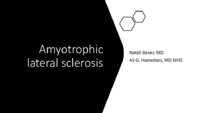 |
Amyotrophic Lateral Sclerosis (ALS) | Natali V. Baner, MD; Ali G. Hamedani, MD, MHS | PowerPoint providing an overview of the definition, clinical presentation and treatment of amyotrophic lateral sclerosis (ALS). | Amyotrophic Lateral Sclerosis (ALS) |
| 40 |
 |
Frontotemporal Dementia: Overview and Neuro-ophthalmologic Features | Pavan Vaswani, MD, PhD; Ali G. Hamedani, MD, MHS | Objectives: Understand the diagnostic criteria for the frontotemporal dementias; Differentiate behavioral variant FTD and the common variants of primary progressive aphasia; Recognize neuro-ophthalmologic and imaging features seen in FTD syndromes | Frontotemporal Dementia |
| 41 |
 |
Medicolegal and Ethical Considerations in Ophthalmology | M. Tariq Bhatti, MD | Slideshow describing topic. | Ethics; Legal |
| 42 |
 |
Maintenance of Certification Basics: American Board of Psychiatry and Neurology | Sean Gratton, MD | Video lecture covering certification basics. | Credentialing |
| 43 |
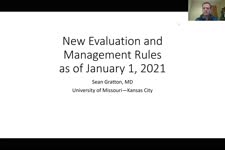 |
New Evaluation and Management Rules for 2021 | Sean Gratton, MD | Overview of the coding rule changes implemented on January 1, 2021. | Coding Rules |
| 44 |
 |
Crafting a Grant Proposal for Research | Silvia Sörensen, PhD | Lecture describing the process of writing a grant for research. | Grant Writing |
| 45 |
 |
Grant Pieces - Research Grants | Silvia Sörensen, PhD | Lecture describing the parts of a research grant, including using human subjects. | Grant Writing |
| 46 |
 |
Protecting Human Subjects in Biomedical Research | Lisa R. Latchney, MS, CCRC | PowerPoint discussion of the history and development of ethics regulations in health research. | Ethical Issues in Research; Consent |
| 47 |
 |
Manuscripts: You Can Write These! | Elaine Smolock, PhD | Overview of writing techniques and parts of the manuscript, basic approach to writing results sections, what makes a good introduction, crafting a meaningful discussion, abstract and title suggestions, and how to get your editor's attention. | Writing Techniques |
| 48 |
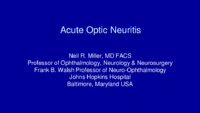 |
Acute Optic Neuritis | Neil R. Miller, MD, FACS | Overview of acute optic neuritis. | Optic Neuritis |
| 49 |
 |
Afferent Visual Pathway Disorders: Typical vs Atypical Optic Neuritis | Carmen Chan, FRCP, FRCOphth, FRCSEd(Ophth), FHKAM(Ophthalmology) | Discussion of typical vs atypical optic neuritis. | Optic Neuritis |
| 50 |
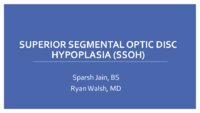 |
Superior Segmental Optic Disc Hypoplasia (SSOH) "Topless Disc Syndrome" | Sparsh Jain, Medical Student; Ryan Walsh, MD | This is a case of superior segmental optic disc hypoplasia that was found incidentally after a screening visual field test revealed an asymptomatic inferior field defect in the left eye. The patient has a unilateral SSOH in the left eye. | Superior Segmental Optic Disc Hypoplasia (SSOH) |
| 51 |
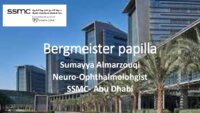 |
Bergmeister Papilla | Sumayya Almarzouqi, MD | A brief overview of Bergmeister papilla, a rare congenital disc anomaly. It arises from the center of the optic disc consists of a small tuft of fibrous tissue and represents a remnant of the fetal hyaloid artery. | Bergmeister Papilla |
| 52 |
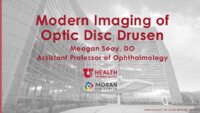 |
Modern Imaging of Optic Disc Drusen | Meagan Seay, DO | This is a short powerpoint describing imaging techniques (specifically OCT-EDI, fundus autofluorescence, and B-scan ultrasonography) for optic disc drusen. Examples of these techniques are included. | Optic Disc Drusen; Imaging; OCT-EDI; Fundus Autofluorescence; B-scan Ultrasonography |
| 53 |
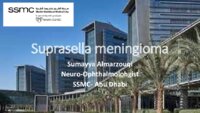 |
Suprasellar Meningioma | Sumayya Almarzouqi, MD | Description of a case of suprasellar or sellar mass causeing chiasmal compression. | Suprasellar Meningioma |
| 54 |
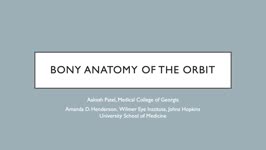 |
Bony Anatomy of the Orbit | Aakash Patel; Amanda Henderson, MD | Narrated presentation on the bony anatomy of the orbit. | Bony Anatomy; Orbit |
| 55 |
 |
Ocular Surface, Cornea, & Lens | Sari Yordi, MD | Video lecture on the anatomy of the ocular surface, cornea, and lens. | Ocular Surface; Cornea; Lens |
| 56 |
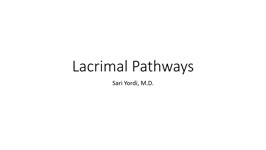 |
Lacrimal Pathways: Anatomy and Physiology | Sari Yordi, MD | Video lecture covering anatomy and physiology of the lacrimal pathways. | Lacrimal Pathways |
| 57 |
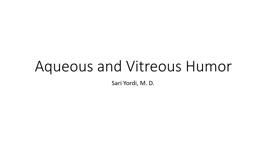 |
Aqueous and Vitreous Humor | Sari Yordi, MD | Narrated lecture on the aqueous and vitreous humor. | Aqueous; Vitreous Humor |
| 58 |
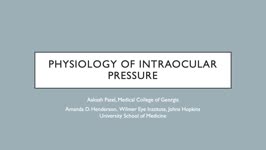 |
Physiology of Intraocular Pressure | Aakash Patel; Amanda Henderson, MD | Overview of the physiology of intraocular pressure. | Intraocular Pressure; Physiology |
| 59 |
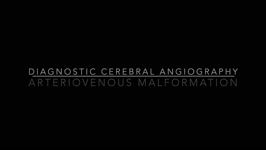 |
Arteriovenous Malformation | Justin Gibson, MD; Charles Prestigiacomo, MD | A diagnostic cerebroangiogram performed on a patient who presented with worst headache of life, found to have a Fisher Grade 3 subarachnoid hemorrhage. | Angiogram; Arteriovenous Malformation; AVM |
| 60 |
 |
Large Vessel Occlusion | Justin Gibson, MD; Charles Prestigiacomo, MD | Example of a diagnostic cerebroangiogram performed on a patient undergoing a stroke. | Angiogram; Stroke |
| 61 |
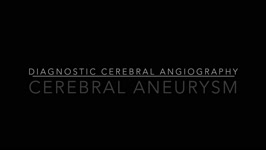 |
Cerebral Aneurysm | Justin Gibson, MD; Charles Prestigiacomo, MD | Cerebral angiogram of a patient with an arteriovenous malformation, or AVM. | Angiogram; Cerebral Aneurysm |
| 62 |
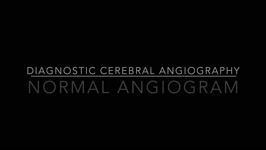 |
Normal Angiogram | Justin Gibson, MD; Charles Prestigiacomo, MD | Example of a normal diagnostic cerebroangiogram. | Angiogram |
| 63 |
 |
Anaesthesia for Eye Surgery and Associated Complications | Julie Smith, MBBS, FANZCA | Lecture covering commonly performed eye surgery and anaesthetic techniques. | Eye Surgery; Anesthesia |
| 64 |
 |
Neuroablative Procedures | Benjamin Jonker, MB BS, MMed(Clin Epi), FRACS | Video lecture covering neuro-ablative procedures that are relevant to neuro-ophthalmologists. | Ablative Procedures |
| 65 |
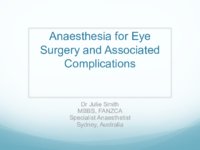 |
Anaesthesia for Eye Surgery and Associated Complications Slides | Julie Smith, MBBS, FANZCA | Lecture covering commonly performed eye surgery and anaesthetic techniques. | Eye Surgery; Anesthesia |
| 66 |
 |
Embryology of the Eye | Yesha Shah, BSA, BBA; Amanda Henderson, MD | Video lecture covering the embryology of the eye. | Embryology; Eye |
| 67 |
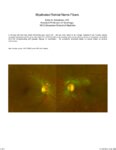 |
Myelinated Retinal Nerve Fibers | Scott N. Grossman, MD | A 33 year old man has noted chronically poor vision OS - left eye color noted to be 'orange' instead of red. fundus photos revealed myelinated retinal nerve fiber layer OU (OS>OD) with corresponding linear paracentral scotoma on Humphrey visual field 24-2 OS corresponding with greatest degree of my... | Myelinated Retinal Nerve Fibers |
| 68 |
 |
Cerebellar Anatomy on MRI | Joshua East, MD; Nicholas A. Koontz, MD; Devin D. Mackay, MD | Overview of structural anatomy of the cerebellum and surround structures on MRI images of the brain. | Cerebellar Anatomy; MRI |
| 69 |
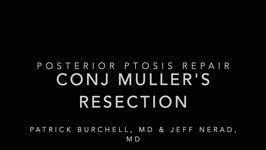 |
Conjunctiva Muller's Muscle Resection | Patrick Burchell, MD; Jeffrey Nerad, MD | Demonstration of conjunctiva Muller's muscle resection (CMMR). | Conjunctiva Muller's Muscle Resection; CMMR |
| 70 |
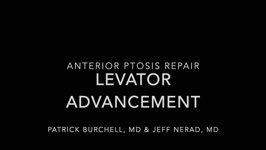 |
Anterior Ptosis | Patrick Burchell, MD; Jeffrey Nerad, MD | Demonstration of anterior ptosis repair, levator advancement. | Anterior Ptosis |
| 71 |
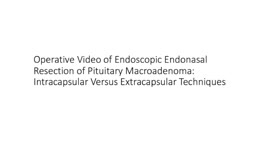 |
Pituitary Surgery | Jonathan Forbes | Operative video of endoscopic endonasal resection of pituitary macroadenoma. Describes intracapsular versus extracapsular techniques. | Pituitary Surgery |
| 72 |
 |
Peripapillary Myelinated Nerve Fibers | John J. Chen, MD, PhD | Fundus photographs of a 19-year old female with prominent peripapillary myelinated nerve fibers in both eyes that was incidentally found on routine eye examination. | Myelinated Nerve Fibers |
| 73 |
 |
Myelinated Nerve Fibers | John J. Chen, MD, PhD | Fundus photographs of a 19-year old female with prominent peripapillary myelinated nerve fibers in both eyes that was incidentally found on routine eye examination. | Myelinated Nerve Fibers |
| 74 |
 |
Myelinated Nerve Fibers | Carmen Chan,RN, PhD, FAAN | Fundus photos from a patient with extensive myelinated nerve fibers. The patient had normal visual functions. | Myelinated Nerve Fibers |
| 75 |
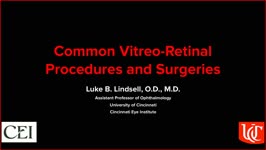 |
Common Vitreo-Retinal Procedures and Surgeries | Luke B. Lindsell, OD, MD | Brief presentation on Common vitreo-retinal procedures and surgeries. | Vitreo-Retinal Procedures; Surgeries |
| 76 |
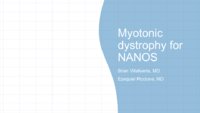 |
Myotonic Dystrophy | Brian Villafuerte, MD, Ezequiel Piccione, MD | Presentation covering an overview of myotonic dystrophy. | Myotonic Dystrophy |
| 77 |
 |
Congenital Hydrocephalus | Mays El-Dairi, MD | Presentation covering an overview of congenital hydrocephalus. | Congenital Hydrocephalus |
| 78 |
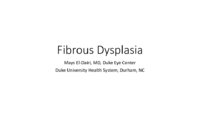 |
Fibrous Dysplasia | Mays El-Dairi, MD | Presentation covering an overview of fibrous dysplasia. | Fibrous Dysplasia |
| 79 |
 |
Optic Neuropathy: A Recipe for Blindness | Karim Kozhaya, MD; Alaa Bou Ghannam, MD; Alfredo Sadun, MD, PhD | An epidemic of blindness and peripheral neuropathy struck Cuba in the early 90s. By the end of 1993, 7% of the population was affected. Most patients were men and presented with sub-acute, painless, bilateral loss of vision. The etiology of the disease pondered local and international scientists, es... | Cuban Epidemic Optic Neuropathy; Leber's Hereditary Optic Neuropathy; Mitochondrial Insufficiency; Nutritional Optic Neuropathy; Pale Optic Nerve |
| 80 |
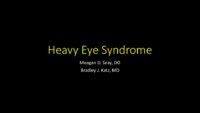 |
Heavy Eye Syndrome | Meagan D. Seay, DO; Bradley J. Katz, MD | A brief overview of heavy eye syndrome. | Heavy Eye Syndrome |
| 81 |
 |
Brown Syndrome | Meagan Seay, DO | A brief overview of Brown Syndrome. | Brown Syndrome |
| 82 |
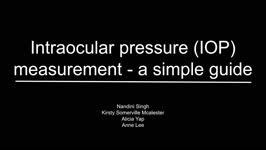 |
Intraocular Pressure (IOP) Measurement: A Simple Guide | Nandini Singh; Kirsty Sumerville Mcalester; Alicia Yap; Anne Lee | This video demonstrates the technique for measuring intraocular pressure (IOP) and the use of the tonopen. | Intraocular Pressure (IOP); Tonometry |
| 83 |
 |
Retinal Detachment: The Basics | Arnav Gupta, BHSc; Rahul Sharma, MD, MPH | A presentation describing retinal detachment. | Retinal Detachment |
| 84 |
 |
Retinal Exudate: The Basics | Arnav Gupta, BHSc; Rahul Sharma, MD, MPH | A presentation describing retinal exudate. | Retinal Exudate |
| 85 |
 |
Retinal Hemorrhage: The Basics | Arnav Gupta, BHSc; Rahul Sharma, MD, MPH | A presentation describing retinal hemorrhage. | Retinal Hemorrhage |
| 86 |
 |
Introduction to the Evaluation of Visual Function in NANOS NOTE | Sean Gratton, MD | Introduction to the Evaluation of Visual Function in NANOS NOTE | Visual Function; Examination |
| 87 |
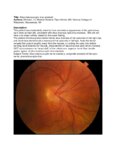 |
Situs Inversus Optic Disc Anomaly | Michael Hii, Medical Student; Ryan Walsh, MD | This patient was incidentally-noted to have anomalous appearance of the optic discs, right more so than left, consistent with situs inversus optic disc anomaly. She did not have any visual deficits related to this exam finding. ; The patient's fundus photos demonstrate situs inversus of the optic ... | Situs Inversus Optic Disc Anomaly |
| 88 |
 |
Temporal Artery Biopsy Procedure | Nooran Badeeb; Danah Albreiki | Temporal artery biopsy is a procedure that is done in a patient with suspicion of GCA (Giant cell Arteritis), and some of the clinical manifestations that prompts us to suspect the diagnosis in patients older than 50 years old are: 1. GCA symptoms e.g. new onset headache. 2 . Visual symptoms: - Visi... | Temporal Artery Biopsy; GCA; Temporal Arteritis |
| 89 |
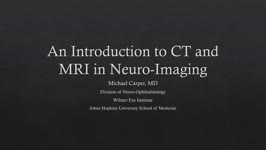 |
An Introduction to CT and MRI in Neuro-Imaging | Michael Carper, MD | A brief lecture covering basic neuro-imaging, including computed tomography (CT) and magnetic resonance imaging (MRI). | Computed Tomography (CT); Magnetic Resonance Imaging (MRI); Neuro-imaging |
| 90 |
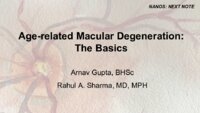 |
Age-related Macular Degeneration: The Basics | Arnav Gupta, BHSc; Rahul Sharma, MD, MPH | A presentation covering age-related macular degeneration ("ARMD" or "AMD"), an acquired, progressive, chronic, degenerative disease of the retina. | Macular Degeneration |
| 91 |
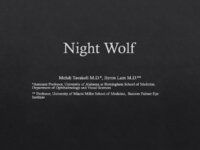 |
Night Wolf | Mehdi Tavakoli, MD; Byron Lam, MD | A case presentation on radiation optic neurology. | Radiation Optic Neuropathy |
| 92 |
 |
Muscular Dystrophy Classification | Brian Villafuerte, MD, Ezequiel Piccione, MD | Presentation covering an overview of muscular dystrophy classification. | Muscular Dystrophy Classification |
| 93 |
 |
Radiation Optic Neuropathy | Neil R. Miller, MD, FACS | Overview of Radiation Optic Neuropathy (RON). | Radiation Optic Neuropathy; RON |
| 94 |
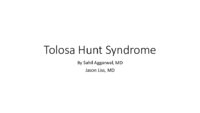 |
Tolosa Hunt Syndrome | Sahil Aggarwal, MD; Jason Liss, MD | Presentation covering an overview of Tolosa Hunt Syndrome. | Tolosa Hunt Syndrome |
| 95 |
 |
Physiology of the Uvea | Aakash Patel; Amanda Henderson, MD | Overview of the physiology of the uvea. | Uvea; Physiology |
| 96 |
 |
Optic Tract Syndrome Secondary to Lacunar Infarction | Justin J. Grassmeyer, PhD; Kenan Xiao, MD; Jason T. Helvey, MD; Sachin Kedar, MD | Lesions of the optic tract produce a characteristic triad of clinical findings: contralateral homonymous hemianopia, contralateral relative afferent pupillary defect, and bilateral optic disc atrophy. This case describes clinical features, radiological findings, and optical imaging characteristics f... | Optic Tract Syndrome; Optic Tract; Lacunar Infarction; Homonymous Hemianopia |
| 97 |
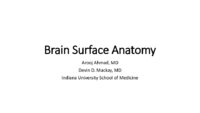 |
Brain Surface Anatomy | Arooj Ahmad, MD; Devin D. Mackay, MD | These images depict labeled structures of the surface anatomy of the different facies of the brain. | Neuroanatomy; Brain Surface Anatomy |
| 98 |
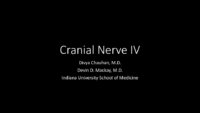 |
The Anatomic Course of Cranial Nerve IV | Divya Chauhan, MD | Overview of the intracranial course of the trochlear nerve. | Cranial Nerve IV; Trochlear Nerve; Anatomy |
| 99 |
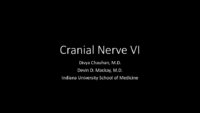 |
The Anatomic Course of Cranial Nerve VI | Divya Chauhan, MD | Overview of the intracranial course of the abducens nerve. | Cranial Nerve VI; Abducens Nerve; Anatomy |
| 100 |
 |
CSF Composition | Divya Chauhan, MD | Overview of the composition of cerebrospinal fluid. | Cerebrospinal Fluid; CSF |
| 101 |
 |
The Internal Carotid Arteries and Branches | Katherine Hutchins, MD; Devin D. Mackay, MD | Illustrations, MRA, CTA, and cerebral angiography images of the internal carotid artery and its branches. | Vascular Anatomy; Internal Carotid Artery; Anterior Cerebral Artery; Middle Cerebral Artery; Anterior Circulation |
| 102 |
 |
The Vertebrobasilar System | Katherine Hutchins, MD; Devin D. Mackay, MD | Illustrations, MRA, and CTA images of the vertebrobasilar system and branches. | Vascular Anatomy; Basilar Artery; Vertebral Artery; AICA; PICA; Superior Cerebellar Artery; Posterior Cerebral Artery; Posterior Circulation |
| 103 |
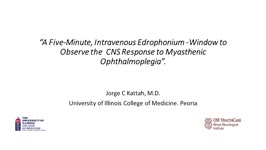 |
A Five-Minute, Intravenous Edrophonium -Window to Observe the CNS Response to Myasthenic Ophthalmoplegia | Jorge C Kattah, MD | A video showing how ocular motor adaptation may be observed. | Ocular Motor Adaptation |
| 104 |
 |
Ptosis | Ethan Waisberg, MB, BCh, BAO candidate | Description of ptosis including etiology, management and treatment. | Ptosis; Blepharoptosis |
| 105 |
 |
Examination of the Lacrimal System | Adam Rasky, MD | Introduction to the examination of the lacrimal system with a video. | Examination; Lacrimal System |
| 106 |
 |
Serial Examination and Evolution of Horizontal Gaze Palsy in Thiamine Deficiency | Maxwell Nyce, OD; Joshua Chisholm, OD; Julia Szmada, OD; Jorge C Kattah, MD | Neurology consult of patient with hearing loss following vertical band sleeve gastroplasty. See associated video: https://collections.lib.utah.edu/details?id=1512438 | Gaze Palsy; Gaze Paretic Nystagmus; Vestibular Loss; Hearing Loss; Loss of Speech Comprehension; Encephalopathy |
| 107 |
 |
Serial Examination and Evolution of Horizontal Gaze Palsy in Thiamine Deficiency | Maxwell Nyce, OD; Joshua Chisholm, OD; Julia Szmada, OD; Jorge C Kattah, MD | Neurology consult of patient with hearing loss following vertical band sleeve gastroplasty. See associated presentation: https://collections.lib.utah.edu/details?id=1512437 | Gaze Palsy; Gaze Paretic Nystagmus; Vestibular Loss; Hearing Loss; Loss of Speech Comprehension; Encephalopathy |
| 108 |
 |
Neuro-ophthalmic Disorders in Pregnancy: With an Eye to Future Eye Health | Kathleen B. Digre, MD | Presentation covering conditions relevant to neuro-ophthalmology, including vascular disorders that affect vision, Pseudotumor Cerebri Syndrome, venous sinus thrombosis, idiopathic intracranial hypertension, and severe pre-eclampsia and eclampsia. | Pregnancy |
| 109 |
 |
Lateral Orbitotomy with Bone Window | Richard C. Allen, MD, PhD, FACS | Narrated video of lateral orbitotomy with bone removal for improved orbital decompression. | Orbitotomy; Orbital Decompression |
| 110 |
 |
Lateral Orbitotomy #3 | Richard C. Allen, MD, PhD, FACS | Narrated video of lateral orbitotomy and biopsy of presumed benign cavernous hemangioma. | Orbital Biopsy; Orbitotomy |
| 111 |
 |
Lateral Orbitotomy #2 | Richard C. Allen, MD, PhD, FACS | Narrated video of lateral orbitotomy and biopsy of presumed orbital inflammatory condition. | Orbital Biopsy; Orbitotomy |
| 112 |
 |
Lateral Canthotomy Incision | Richard C. Allen, MD, PhD, FACS | Narrated video of lateral canthotomy procedure. | Lateral Canthotomy |
| 113 |
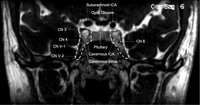 |
Cavernous Sinus | Andrew R. Carey, MD | Cavernous sinus imaging with labels. | Cavernous Sinus |
| 114 |
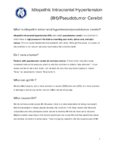 |
Idiopathic Intracranial Hypertension | NANOS | Idiopathic intracranial hypertension (IIH), also called pseudotumor cerebri, is a condition in which there is high pressure in the fluid surrounding your brain, spinal cord, and optic nerves. This can cause headaches and problems with vision. | Idiopathic Intracranial Hypertension; Patient Brochure |
| 115 |
 |
Giant Cell Arteritis | NANOS | Giant cell arteritis is a condition that can cause vision loss, new persistent headaches, scalp tenderness, and jaw pain with chewing. It is due to inflammation of blood vessels primarily of the head and neck. | Giant Cell Arteritis; Patient Brochure |
| 116 |
 |
Thyroid Eye Disease | NANOS | Thyroid eye disease, also called dysthyroid orbitopathy, is an autoimmune condition in whichyour body's immune system triggers inflammation in the eye socket (also called the orbit),affecting the muscles that move the eye and the fatty tissue behind the eye. | Thyroid Eye Disease; Thyroid Orbitopathy; Patient Brochure |
| 117 |
 |
Optic Nerve Sheath Meningioma | NANOS | Optic nerve sheath meningioma is a benign (not malignant) tumor which involves the covering of the optic nerve. Meningiomas (along with gliomas and pituitary tumor) are the most common tumors inside the skull. | Optic Nerve Sheath Meningioma; Patient Brochure |
| 118 |
 |
Progressive Supranuclear Palsy | NANOS | Progressive Supranuclear Palsy (PSP) is a rare progressive neurodegenerative disorder that affects certain parts of the brain, resulting in difficulty with balance, walking, swallowing, and vision. | Progressive Supranuclear Palsy; Patient Brochure |
| 119 |
 |
Menieres Disease | NANOS | Menière's Disease is named after Prosper Menière, a French physician who first described the condition in 1861. It is an inner ear disorder that can cause vertigo (false sensation of motion). | Menieres Disease; Patient Brochure |
| 120 |
 |
Eyelid Myokymia | NANOS | Eyelid myokymia is a very common condition that many people have experienced at least briefly at one time or another, though the exact prevalence is not known. Myokymia is characterized by involuntary fine contractions or "twitching" of the eyelids. | Eyelid Myokymia; Patient Brochure |
| 121 |
 |
The Mental Status Examination (MSE): The Basics | Victoria S. Pelak, MD | An overview of the Mental Status Examination. | Mental Status Examination; Examinations |
| 122 |
 |
Management of Non-Organic Vision Loss | Aumer Shughoury, BA; Devin D. Mackay, MD | A description of the management of non-organic visual loss. | Non-Organic Vision Loss; NOVL |
| 123 |
 |
Confrontation Visual Fields - A Concise Guide for Ophthalmology and Neurology Trainees | Stephen C. Pollock, MD | The guide describes the techniques required to competently perform confrontation visual fields. It outlines a basic screening protocol and discusses methods for further defining defects identified during the screening process. A mini-atlas of visual field defects is included as an appendix. | Confrontation Visual Fields; Visual Field Testing; Perimetry; Visual Field Loss; Visual Field Defect; Ocular Examination; Visual Sensory Evaluation; Neurologic Examination |
| 124 |
 |
Right Lateral Medulla and Cerebellar Stroke | Jorge C Kattah, MD | This patient presented with an acute vestibular syndrome, he has a h-left beat nystagmus and a normal head impulse test . He had grade 3 truncal ataxia and severe ocular lateropulsion to the right (type 1 overt OL). Hypometric leftward, centripetal, slow saccades were video-recorded even six weeks... | Right Lateral Medulla; Cerebellar Stroke |
| 125 |
 |
Ocular Lateropulsion Left AICA Stroke | Jorge C Kattah, MD | 82 year-old patient with basilar artery stenosis, she developed an acute left AICA stroke. On examination within 24 hours from symptom onset, she had primary gaze, unidirectional, right beat nystagmus and a positive left head impulse test. Brief periods of eyelid closure were associated with a h-... | Ocular Lateropulsion; AICA Stroke |
| 126 |
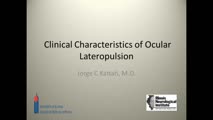 |
Clinical Characteristics of Ocular Lateropulsion | Jorge C Kattah, MD | A discussion of the normal mechanism that maintain the eyes in normal horizontal position. | Ocular Lateropulsion; Unilateral Gaze Palsy; Radiographic h-CGD |
| 127 |
 |
Convergence-Retraction Nystagmus in Dorsal-Midbrain Syndrome | Paul Freund, MD, FRCSC; Edward Margolin, MD, FRCSC | A man in his early twenties was referred by optometrist for abnormal eye motility findings. He had a remote history of an excised pinealoma. On exam he had almost complete upgaze palsy, convergence-retraction nystagmus on attempted upgaze, and light-near dissociation of pupillary reaction, the class... | Dorsal Midbrain Syndrome; Parinaud Syndrome; Convergence-Retraction Nystagmus; Light-Near Dissociation |
| 128 |
 |
Dual Visual Field Defect (Quadrantanopia and Central Scotoma) Unmasks the Hidden Brain Lesion in a Patient with Non-arteritic Ischemic Optic Neuropathy | A. Mohan Kannam; B. Rajat Kapoor; C. Ramesh Kekunnaya, FRCS; Virender Sachdeva, MS, DNB | This submission is an interesting case that highlights the co-existence of two different visual field defects in the same patient presenting to us with clinical picture of non arteritic ischemic optic neuropathy. The correct interpretation of the visual field defects led to the appropriate localizat... | Hemianopia; Central Field Defect; Non-Arteritic Ischemic Optic Neuropathy; Ischemic Infarct |
| 129 |
 |
Introduction to Diagnostic Testing: Audio-Vestibular | Daniel R. Gold, DO | Introduction to the audio-vestibular diagnostic testing section of the NExT curriculum. | Diagnostic Testing; Exams; Audio-Vestibular |
| 130 |
 |
Introduction to Examination of the Vestibular System | Daniel R. Gold, DO | Introduction to the Vestibular System Examination section of the NExT curriculum. | Exams; Vestibular System |
| 131 |
 |
Clinical Visual Electrophysiology | Gregory P. Van Stavern, MD; Byron Lam, MD | A description of the use of electrophysiology to examine the visual system. | Electrophysiology; Visual Exam |
| 132 |
 |
Fundus Fluorescein Angiography: What Is It and When Is It Useful for Neuro-Ophthalmology? | Clare L. Fraser, MBBS; Elisa E. Cornish, PhD | An introduction to the use of fluorescein angiography. | Fluorescein Angiography; Visual Exam |
| 133 |
 |
Hirschberg Test Corneal Reflex Test | Nagham Al-Zubidi, MD | Description of the Hirschberg test a the corneal reflex test. | Hirschberg Test; Corneal Reflex |
| 134 |
 |
Introduction to Ocular Examination | Ore-ofe Adesina, MD | Introduction to the Ocular Examination section of the NExT curriculum. | Exams; Ocular Examination |
| 135 |
 |
Introduction to Funduscopic Examination | Valérie Biousse, MD | Introduction to the funduscopic examination section of the NExT curriculum. | Exams; Funduscopy |
| 136 |
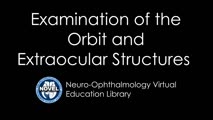 |
Examination of the Orbit and Extraocular Structures | Julie Falardeau, MD | Introduction to the Examination of Orbit and Extraocular Structures in the NExT curriculum. | Exams; Orbit; Extraocular |
| 137 |
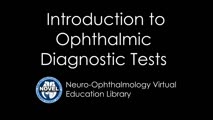 |
Introduction to Ophthalmic Diagnostic Tests | Valérie Biousse, MD | Introduction to the ophthalmic diagnostic testing section of the NExT curriculum. | Exams; Diagnostics |
| 138 |
 |
Other Special Situations | John Pula, MD | Introduction to examinations in special situations. | Exams |
| 139 |
 |
Testing Eye Movements | Marc Dinkin, MD | Description of eye movement testing. | Eye Movements; Exams |
| 140 |
 |
The Mental Status Examination - Non-Cognitive | James R. Bateman, MD, MPH; Victoria S. Pelak, MD | Introduction to the mental status examination. | Mental Status; Non-Cognitive Function |
| 141 |
 |
The Mental Status Examination - Cognitive | James R. Bateman, MD, MPH; Victoria S. Pelak, MD | Introduction to the cognitive mental status examination. See accompanying videos: Executive function: https://collections.lib.utah.edu/ark:/87278/s6bw1rp1, Limb-Kinetic apraxia: https://collections.lib.utah.edu/ark:/87278/s63c084b, Ideomotor apraxia: https://collections.lib.utah.edu/ark:/87278/s674... | Mental Status; Cognitive Function |
| 142 |
 |
The Clinical Examination of Higher Order Visual Function: Syndrome-based Approach - Visual Neglect | Victoria S. Pelak, MD; James R. Bateman, MD, MPH; Brianne Bettcher, PhD | Explanation of higher order visual function examination. See accompanying video, Double simultaneous visual field stimulation: https://collections.lib.utah.edu/ark:/87278/s6gn2h9d | Visual Function; Visual Neglect |
| 143 |
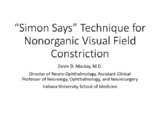 |
"Simon Says" Technique for Nonorganic Visual Field Constriction | Devin D. Mackay, MD | Explanation of the "Simon says" technique. | Simon Says, Visual Field Constriction |
| 144 |
 |
The Clinical Examination of Higher Order Visual Function: Syndrome-based Approach - Visual Simultanagnosia | Victoria S. Pelak, MD; James R. Bateman, MD, MPH; Brianne Bettcher, PhD | Explanation of higher order visual function examination. | Visual Function; Visual Simultanagnosia |
| 145 |
 |
The Clinical Examination of Higher Order Visual Function: Syndrome-based Approach - Visual Prosopagnosia | Victoria S. Pelak, MD; James R. Bateman, MD, MPH; Brianne Bettcher, PhD | Explanation of higher order visual function examination. | Visual Function; Visual Prosopagnosia |
| 146 |
 |
The Clinical Examination of Higher Order Visual Function: Syndrome-based Approach - Visual Central Achromatopsia | Victoria S. Pelak, MD; James R. Bateman, MD, MPH; Brianne Bettcher, PhD | Explanation of higher order visual function examination. | Visual Function; Visual Central Achromatopsia |
| 147 |
 |
The Clinical Examination of Higher Order Visual Function: Syndrome-based Approach - Visual Constructional Apraxia | Victoria S. Pelak, MD; James R. Bateman, MD, MPH; Brianne Bettcher, PhD | Explanation of higher order visual function examination. | Visual Function; Visual Constructional Apraxia |
| 148 |
 |
Neuropsychological Assessment | Brianne M. Bettcher, PhD; James R. Bateman, MD, MPH; Victoria S. Pelak, MD | Introduction to neuropsychology and neuropsychological assessments. | Neuropsychological Assessment |
| 149 |
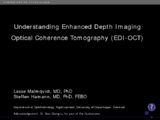 |
Understanding Enhanced Depth Imaging Optical Coherence Tomography (EDI-OCT) | Lasse Malmqvist, MD, PhD; Steffen Hamann, MD, PhD, FEBO | This is an explanation of using the enhanced depth imaging optical coherence tomography technique for examination. | Enhanced Depth Imaging |
| 150 |
 |
Introduction to the Slit Lamp and the Slit Lamp Examination | Chris Bair, MD and Tyler Quist, MD | This brief video from fourth-year medical students Chris Bair and Tyler Quist discusses the details of your ophthalmology rotation at the Moran Eye Center, as well as providing a primer on how to use the slit lamp and perform a basic eye exam. | Medical Student; Exam; Education |
| 151 |
 |
The Ocular Examination of the Comatose Patient | John Pula, MD | Description of conducting an ocular examination of a comatose patient. | Examination; Coma |
| 152 |
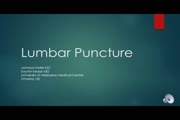 |
Lumbar Puncture | Jamison Hofer, DO; Sachin Kedar, MD | Explanation of lumbar puncture procedure. | Lumbar Puncture |
| 153 |
 |
The Mental Status Examination | James R. Bateman, MD, MPH; Victoria S. Pelak, MD | Introduction to the mental status examination. See accompanying videos: Executive function: https://collections.lib.utah.edu/ark:/87278/s6bw1rp1, Limb-Kinetic apraxia: https://collections.lib.utah.edu/ark:/87278/s63c084b, Ideomotor apraxia: https://collections.lib.utah.edu/ark:/87278/s67410xj | Mental Status |
| 154 |
 |
The Clinical Examination of Higher Order Visual Function: Syndrome-Based Approach | Victoria S. Pelak, MD; James R. Bateman, MD, MPH; Brianne Bettcher, PhD | Explanation of higher order visual function examination. See accompanying video, Double simultaneous visual field stimulation: https://collections.lib.utah.edu/ark:/87278/s6gn2h9d | Visual Function |
| 155 |
 |
Double Simultaneous Visual Field Stimulation | Victoria S. Pelak, MD; James R. Bateman, MD, MPH; Brianne Bettcher, PhD | Explanation of the double simultaneous visual field exam, as part of the larger higher order visual function examination. Video accompanies The Clinical Examination of Higher Order Visual Function: Syndrome-based Approach: https://collections.lib.utah.edu/ark:/87278/s6837zqp and Visual Neglect: http... | Visual Function; Visual Fields |
| 156 |
 |
Executive Function | James R. Bateman, MD, MPH; Victoria S. Pelak, MD | Introduction to the executive function exam as part of the larger mental status examination. Video accompanies the The Mental Status Examination lecture at https://collections.lib.utah.edu/ark:/87278/s64b7716 and Cognitive Assessment at: https://collections.lib.utah.edu/ark:/87278/s6qc49rx | Mental Status |
| 157 |
 |
Ideomotor Apraxia | James R. Bateman, MD, MPH; Victoria S. Pelak, MD | Introduction to the ideomotor apraxia exam as part of the larger mental status examination. Video accompanies the The Mental Status Examination lecture at https://collections.lib.utah.edu/ark:/87278/s64b7716 and Cognitive Assessment at: https://collections.lib.utah.edu/ark:/87278/s6qc49rx | Mental Status |
| 158 |
 |
Limb-Kinetic Apraxia | James R. Bateman, MD, MPH; Victoria S. Pelak, MD | Introduction to the limb kinetic apraxia exam as part of the larger mental status examination. Video accompanies the The Mental Status Examination lecture at https://collections.lib.utah.edu/ark:/87278/s64b7716 and Cognitive Assessment at: https://collections.lib.utah.edu/ark:/87278/s6qc49rx | Mental Status |
| 159 |
 |
Using Pupillometry in Clinical Medicine | Aki Kawasaki, MD | Description of the use of pupillometry in clinical medicine. | Pupillometry |
| 160 |
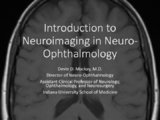 |
Introduction to Neuroimaging in Neuro-Ophthalmology | Devin D. Mackay, MD | Introduction to the subject of neuroimaging in the field of neuro-ophthalmology. | Imaging |
| 161 |
 |
Contrast Sensitivity | Sean Gratton, MD | Explanation of contrast sensitivity. | Contrast Sensitivity |
| 162 |
 |
Eye Drop Instillation: Technique & Indications | Karl C. Golnik, MD | Description and demonstration of eye drop instillation. | Eye Drops |
| 163 |
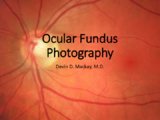 |
Ocular Fundus Photography | Devin Mackay, MD | Overview of the various ocular fundus cameras and how they are used, including: Digital mydriatic tabletop fundus camera, Digital nonmydriatic table top fundus camera, Digital handheld nonmydriatic fundus camera and the Smartphone handheld fundus camera. | Digital Fundus Photography; Imaging |
| 164 |
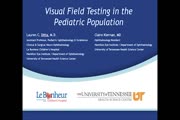 |
Visual Field Testing in the Pediatric Population | Lauren C. Ditta, MD | Visual field testing can be performed in the pediatric population with ease, however the proper technique for testing must be utilized and is tailored to each child's unique clinical situation and age. Confrontation visual field testing is a quick and easy; test that can yield a rough assessment of ... | Visual Field Testing; Pediatric; Confrontation Visual Field; Automated; Perimetry |
| 165 |
 |
Ectropion and Entropion | Julie Falardeau, MD; Eric A. Steele, MD | This is a brief PowerPoint presentation describing 2 common disorders of eyelid position: ectropion and entropion. We provide the classification of these 2 disorders as well as clinical photographs | Ectropion; Entropion; Eyelid |
| 166 |
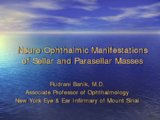 |
Neuro-Ophthalmic Manifestations of Sellar and Parasellar Masses | Rudrani Banik, MD | Neuroanatomy of the Chiasm. | Parasellar Masses |
| 167 |
 |
Introduction to the Evaluation of Visual Function | Sean Gratton, MD | An introduction to evaluating a patient's visual function. | Visual Function |
| 168 |
 |
Distance Visual Acuity Testing | Sean Gratton, MD | Demonstration of measuring distance visual accuity. | Visual Acuity Testing |
| 169 |
 |
Red Color Desaturation | Sean Gratton, MD | Exploring red color desaturation. | Red Color Desaturation |
| 170 |
 |
Refraction | Sean Gratton, MD | An introduction to refraction. | Refraction |
| 171 |
 |
Lagophthalmos | Julie Falardeau, MD; John D. Ng, MD | This is a brief PowerPoint presentation for the NANOS Examination Curriculum describing how to evaluate lagophthalmos, discussing the main causes of lagophthalmos and demonstrating few clinical examples. | Lagophthalmos; Eyelid |
| 172 |
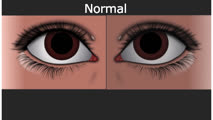 |
Normal Light Reflex and Relative Afferent Pupillary Defect (RAPD) | Marshall Huang, 4th Year Medical Student | A Relative Afferent Pupillary Defect is an examination finding in patients who have an asymmetric pupillary reaction to light when it is shined back and forth between the two eyes. It is most commonly a sign of asymmetric optic nerve disease or damage but can also present in widespread asymmetric r... | Light Reflex; RAPD |
| 173 |
 |
Examination of Lymph Nodes | John D. Ng, MD, MS, FACS | Demonstration of lymph node examination. | Exam; Lymph Nodes |
| 174 |
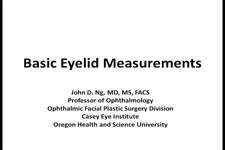 |
Basic Eyelid Measurements | John D. Ng, MD, MS, FACS | Demonstration of basic eyelid measurements. | Eyelid |
| 175 |
 |
Ice Test in Myasthenic Ptosis | Julie Falardeau, MD | Demonstration of ice test. | Ice Test; Myasthenic Ptosis |
| 176 |
 |
Tonometry | Ore-ofe Adesina, MD | Presentation covering the measurement of intraocular pressure, Tonometry. Covers indentation, applantation and electronic tonometry. | Tonometry; Intraocular Pressure |
| 177 |
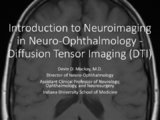 |
Diffusion Tensor Imaging (DTI) | Devin D. Mackay, MD | Explanation of using diffusion tensor imaging (DTI) in examinations. | Diffusion Tensor Imaging (DTI) |
| 178 |
 |
NExT Introduction | Sachin Kedar, MD, Editor-in-Chief | Transcript of video introduction to the NExT curriculum collection. | NANOS Examination Techniques |
| 179 |
 |
Introduction to Neurological Imaging | Devin Mackay, MD | Introduction to the techniques of neurological imaging examination. | Neurological Imaging |
| 180 |
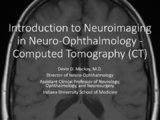 |
Computed Tomography (CT) | Devin D. Mackay, MD | Explantation of computed tomography (CT) examinations. | Computed Tomography (CT) |
| 181 |
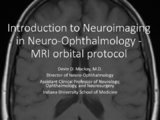 |
MRI Orbital Protocol | Devin D. Mackay, MD | Description of the MRI orbital protocol. | MRI Orbital Protocol |
| 182 |
 |
MR Angiography (MRA) | Devin D. Mackay, MD | Explanation of using MR angiography in examinations. | MR Angiography (MRA) |
| 183 |
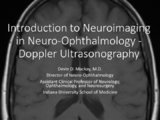 |
Doppler Ultrasonography | Devin D. Mackay, MD | Explanation of using doppler ultrasonography in examinations. | Doppler Ultrasonography |
| 184 |
 |
CT Angiography (CTA) | Devin D. Mackay, MD | Explanation of using computed tomography angiography (CTA) in examinations. | CT Angiography (CTA) |
| 185 |
 |
Paediatric Neuro-ophthalmology: Visual Acuity Assessment Strategies | Anat Bachar Zipori, MD; Nasrin Najm-Tehrani, FRCS Ed (Ophth), FRCSC | Assessing the visual function of a child can be challenging at times. When approaching a child one must understand visual development and accommodate to the child's capabilities, level of development and communication skills. The examining physician may need to apply more than one method to assess t... | Visual Acuity Assessment; Pediatric Visual Acuity Tests |
| 186 |
 |
Pediatric Visual Acuity Strategies: Induced Tropia Test | Anat Bachar Zipori, MD; Nasrin Najm-Tehrani, FRCS Ed (Ophth), FRCSC | Induced Tropia Test. Using a 10-20 base-down prism, this exam demonstrates equal vision in both eyes. If there is evidence of ocular misalignment, prisms can be used to neutralize the movement and thereby measure the deviation, whether it is a heterotropia or heterophoria. Prisms are placed in front... | Induced Tropia; Prism Test |
| 187 |
 |
Vertical optokinetic nystagmus | Anat Bachar Zipori, MD; Nasrin Najm-Tehrani, FRCS Ed (Ophth), FRCSC | Visual depiction of the vertical OKN drum test. The vertical optokinetic drum test is an exam used to elicit vertical optokinetic nystagmus (OKN) when there is horizontal nystagmus. The hand-held "optokinetic" drums or tapes that are used to elicit smooth movements primarily test the pursuit system.... | Vertical Optokinetic Nystagmus; OKN Drum Test |
| 188 |
 |
Horizontal Right Optokinetic Nystagmus | Anat Bachar Zipori, MD; Nasrin Najm-Tehrani, FRCS Ed (Ophth), FRCSC | Visual depiction of the horizontal OKN drum test. The hand-held "optokinetic" drums or tapes that are used to elicit smooth movements primarily test the pursuit system. This video supplements Paediatric Neuro-ophthalmology: Visual Acuity Assessment Strategies: https://collections.lib.utah.edu/ark:/... | Horizontal Right Optokinetic Nystagmus; OKN Drum Test |
| 189 |
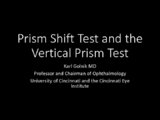 |
Prism Shift Test and the Vertical Prism Test | Karl C. Golnik, MD | Explanation of how to do the prism shift test and the vertical prism test. | Prism Shift Test; Vertical Prism Test |
| 190 |
 |
Introduction to Examination of the Pediatric Patient | Jason H. Peragallo, MD | Introduction to examination of the pediatric patient. | Pediatric Patient |
| 191 |
 |
Functional MRI | Devin D. Mackay, MD | Explanation of using functional MRI in examinations. | Functional MRI |
| 192 |
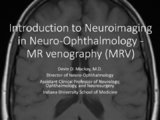 |
MR Venography (MRV) | Devin D. Mackay, MD | Explanation of using MR venography (MRV) in examinations. | MR Venography (MRV) |
| 193 |
 |
CT Venography (CTV) | Devin D. Mackay, MD | Explanation of using computed tomography venography (CTV). | CT Venography (CTV) |
| 194 |
 |
Positron Emission Tomography (PET) | Devin D. Mackay, MD | Explanation of using positron emission tomography (PET) in examinations. | Positron Emission Tomography (PET) |
| 195 |
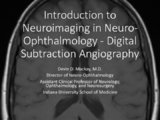 |
Digital Subtraction Angiography | Devin D. Mackay, MD | Explanation of using digital subtraction angiography in examinations. | Digital Subtraction Angiography |
| 196 |
 |
OKN Testing for Non-physiologic Visual Loss | Walsh and Hoyt Clinical Neuro-Ophthalmology, 6th Edition | Description of OKN testing for non-physiologic visual loss. | OKN Testing; Non-physiologic Visual Loss |
| 197 |
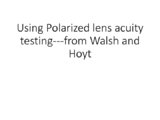 |
Using Polarized Lens Acuity Testing | Walsh and Hoyt Clinical Neuro-Ophthalmology, 6th Edition | Description of using a polarized lense for acuity testing. | Polarized Lens; Acuity Testing |
| 198 |
 |
Proprioception Testing for Non-physiologic Visual Loss | Walsh and Hoyt Clinical Neuro-Ophthalmology, 6th Edition | Description of proprioception for non-physiologic visual loss. | Proprioception Testing; Non-physiologic Visual Loss |
| 199 |
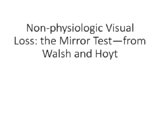 |
Mirror Test for Malingering | Walsh and Hoyt Clinical Neuro-Ophthalmology, 6th Edition | Description of the mirror test. | Mirror Test; Malingering |
| 200 |
 |
Monocular Hemianopia | Walsh and Hoyt Clinical Neuro-Ophthalmology, 6th Edition | Description of testing for a non-physiologic cause of a monocular hemianopia. | Monocular Hemianopia |
